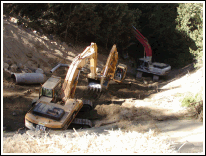 On November 1, 2002, the Karuk Watershed Restoration team, Forest Service Personnel and community members watched with jubilation as the gate was removed and the Steinacher Road Project reached completion. The Watershed Team had worked diligently for three full seasons to finally meet the goal set before them.The Tribal crew is exceedingly proud to have had the opportunity to repair a portion of the landscape of the Karuk Ancestral lands by decommissioning this road that was built in the late 1960s as a major log-haul road.
On November 1, 2002, the Karuk Watershed Restoration team, Forest Service Personnel and community members watched with jubilation as the gate was removed and the Steinacher Road Project reached completion. The Watershed Team had worked diligently for three full seasons to finally meet the goal set before them.The Tribal crew is exceedingly proud to have had the opportunity to repair a portion of the landscape of the Karuk Ancestral lands by decommissioning this road that was built in the late 1960s as a major log-haul road.
The objective of the project was to decrease the sedimentation caused from the road by removing approximately 187,000 cu.yds. of potential sediment, within the Wooley Creek watershed thereby securing the critically important Salmonid refugia from which to restore the Spring Chinook, coho salmon, petitioned Fall Chinook salmon and steelhead trout.
|
Available Video Documentation Karuk Cultural & Ecosystem Restoration Program 1999 ( 221 MB ) |
The Karuk tribe has a vested interest in restoring the traditional ecosystems and culture, and to employ Tribal and local community people within our Ancestral Territory.
The Tribe and the Klamath and Six Rivers National Forests have entered into a Memorandum of Understanding (MOU) based upon the Government-to-Government relationship established between the Tribe and the Forest Service.
This MOU establishes a framework upon which the Tribe and the Forest Service may jointly identify, plan and accomplish mutually beneficial projects and activities that provide for watershed restoration, job opportunities, and community economic development.
Improved watersheds and fisheries are seen as a significant component of rebuilding the economy of the region. Watershed restoration represents an opportunity for long-term, stable employment based on non-resource extraction ecosystem management and a stable, fully functioning ecosystem. An increase in recreation with improved fishing and economic development.
The objective of the Karuk Tribe’s Watershed Restoration Division is to protect the habitat of anadromous fish by decreasing the sedimentation caused by the road networks within watersheds of critical concern. The Tribe accomplishes this by conducting site-specific geomorphic mapping, surveying, prescription design and preparation of work order specifications for implementation of identified project areas. Implementation includes proven road decommissioning methods to remove and/or stabilize unstable logging haul road-stream crossings and to reestablish the natural hillslope drainage pattern along the road. The objective of a decommissioning project is to decrease the sedimentation caused by a road by removing the potential sediment. Decommissioning of roads begin with roads that have the highest density of high hazard sites and that pose the greatest hazard to watershed processes, water quality, and aquatic habitats.
The Karuk Tribe of California has a vested interest in developing an overall "Karuk Cultural Adaptive Management Program" for management of our Ancestral Territory and for the creation of long-term employment for Tribal and community members. Tribal participation in Forest Service planning efforts have been limited, and at best at an advisory level. Due to the extremely rural population of the Mid-Klamath and Salmon River sub-basin and severe budget cuts of the Forest Service personnel the sub-basin planning and subsequent implementation of projects has not generated necessary funding or staff time of habitat recovery.
The Karuk Tribe’s goal is to protect watersheds that serve as habitat for Tribal trust species while maximizing the Tribe’s and local communities long-term economic and cultural benefits. Management policies of the current land managers have undermined traditional avenues of access to resources thus preventing the careful ecosystem tending of the Karuk people. Lack of knowledgeable traditional stewardship has created landscape conditions that have ignored and devastated traditional resources and now threatens the well being of both the forests and the forest based communities. The management of traditional resources through implementation of specific forest management practices requires addressing an intricate complex of political, cultural and technical issues.
Redefining and expanding the role and authority of the Karuk Tribe in managing these traditional resources offers an equitable solution to the current situation. Development of a new relationship between the Karuk Tribe and the Forest Service will require changes in the current management institutions, in the decision making processes of land management and in the access of Karuk people to those resources necessary to our physical and cultural well being. Building the Tribe’s capacity to play an appropriate role in ecosystem management is the only means by which ecosystem restoration, cultural survival and community prosperity will be achieved.
Available Watershed Documents
|

